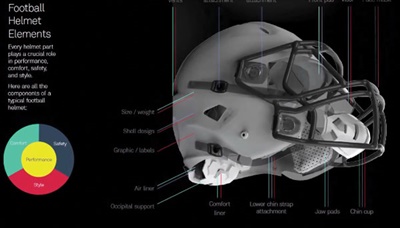The much anticipated movie “Concussion” debuts next week, depicting a formerly little-known doctor and his efforts to publicize the discovery of an unknown brain injury that is linked to football.
The NFL, which initially resisted the findings of the doctor, Bennet Omalu, has since changed its playing rules, seeking to minimize the helmet-to-helmet collisions seen throughout “Concussion.” And even as the movie renews debate about the NFL’s culpability and whether the game (notwithstanding the rule changes) is unsafe, the league is funding a potential breakthrough helmet that the product’s creators say they want to get on NFL and college players next season.
 |
Helmet maker Vicis says its new model distributes impacts throughout the helmet.
|
The Zero1 helmet by Vicis, a University of Washington spinoff, has a malleable shell, unlike the hard exteriors of its competitors. The interior is filled with padding so the inside shell is not visible, unlike in other helmets.
Vicis maintains that the new headgear minimizes the force that can cause concussions by distributing the impact throughout the helmet.
Dave Marver, the company’s CEO and co-founder, has met with team trainers and counts both active and former NFL players on his advisory board. Among those are New Orleans Saints wide receiver Marques Colston and hall of famers Roger Staubach and Tony Dorsett.
But will NFL players wear a helmet that has never been sold and whose exterior is not rock hard?
“Though the shell is deformable, it is still hard,” Marver said. “The helmet is so solidly built and well-fitting [that] it provides a lot of confidence.”
New helmets can make a quick breakthrough. Xenith broke into the business four years ago, and the company now claims two of the top four spots in the new helmet ranking system the NFL introduced before the start of the season to measure the ability to withstand rotational velocity and acceleration impacts.
Stalwarts like Riddell and Schutt still largely dominate the business, but the chances now are better than they’ve been in the past to persuade players to wear new headwear. That’s because players are more aware of concussion issues, and team trainers no longer are the gatekeepers they once were, said Jim Huether, the former chief marketing officer for Xenith and now an executive with Hyperice, which makes injury recovery products.
“There has been a change of mentality of athletic trainers at the NFL level,” Huether said. “They are much more open about others making a choice as opposed to them selecting a specific helmet.”
If the Zero1 makes it onto an NFL field, it would be the first product to emerge commercially out of the league’s $60 million Head Health Initiative, which the league launched in 2013 in conjunction with General Electric and Under Armour to jump-start research and development of concussion prevention, detection and rehabilitation products.
To date, the NFL has awarded the University of Washington $750,000 for research into the helmet, which Vicis is taking to market. There also is an opportunity for a $1 million prize based on whether the technology passes certain technical milestones in the next year.
Vicis is certainly not waiting a year. The company plans to fully unveil the helmet at the American Football Coaches Association conference in San Antonio next month and make a presentation around Super Bowl week. It also is sponsoring an inaugural award with the Maxwell Club to recognize athletic trainers who promote safety (to be presented next year), and it will seek certification with the National Operating Committee on Standards for Athletic Equipment, a key requirement for the helmet to be allowed on football fields at any level.
Asked about the science in the helmet, Marver declined to answer. Sitting in the basement of NFL headquarters recently, where the league invited reporters to interview the three companies that received a second grant as part of the Head Health Initiative, his product sat in front of him. The exterior was taped over; inside, there was foam to obscure certain areas — a step Marver said was necessary to keep the technology from competitors, for now.
Behind Marver, a video played superimposing the Zero1 helmet with a robot head in it, juxtaposed against a traditional helmet. The two helmets are violently hit, and the head in the traditional helmet snaps back at a far greater angle than the one in the Zero1.
Helmets and their solid shell were designed to prevent skull fractures, not concussions. The makers of the Zero1, so named to conjure up the goal of zero concussions, plan to market their softer helmet with the claim that it reduces the forces that cause concussions. The NFL also said the company can market that it received funding from the league in the development of the helmet.
The pace of commercialization is quick for Vicis. Take one of the other repeat winners: the Army Research Lab, which developed a tether that attaches to a helmet’s face mask and connects to a body harness worn around the waist. The tether activates to hold the helmet steady when the head quickly moves backward, the kind of movement that caused Case Keenum’s widely publicized concussion. Eric Wetzel, a research scientist with the lab, said the Army plans discussions with third parties to perhaps bring the product to market but that those talks had not begun.
The third repeat winner is a company called Viconic, which makes a turf underlay system touted to soften the impact when players hit the ground. Its first test on an actual field is scheduled to occur this spring at the University of Tennessee.




